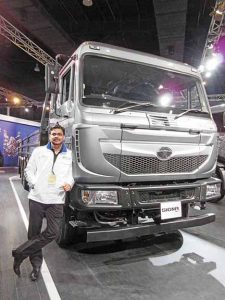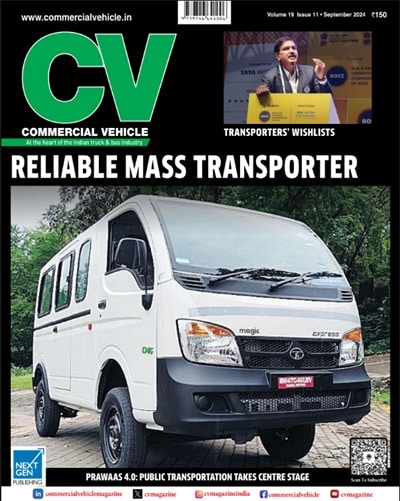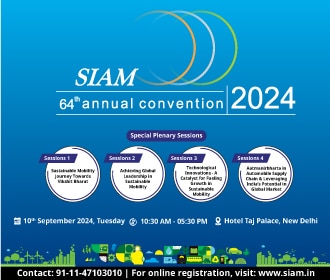Q & A
Girish Wagh,
Head – Commercial Vehicles Business Unit, Tata Motors
Interview & photo by : Anirudh Raheja
Q. What new products will Tata Motors unveil in 2018?
A. As a full-range CV player we have unveiled 15 vehicles at Auto Expo 2018. Some of them are concepts, and some of them are vehicles ready to be produced. In the SCV segment, we have unveiled the Intra. It is our first vehicle on the new modular platform. The Intra points at the migration towards bigger and higher payload CVs in every segment. In fact, the Intra is not the only one that indicates the migration towards bigger and higher payload CVs, it is the case with every product that we have unveiled. Our stress on modular platforms will give us an opportunity to seek multiple wheelbases and powertrains. It will also give us an opportunity to seek cabin trim options to suit various applications. In the LCV segment, we have launched new product on the Ultra platform, which is modular in nature. It has a new cabin, a powerful three-litre Turbrotron engine. This LCV, we are confident, will help us to tap the movement we are seeing in that respective segment. We are also confident of using the Ultra platform to tap the movement in the LCV segment. In the M&HCV segment, we have launched the 4323. It is the first six-axle truck in the 43-tonne segment. It will help us and the buyer to get past the stricter implementation of rated payload. The 3718 truck has become one of the biggest vehicles today. It will reduce the operating costs of the transporter and improve the revenue potential. In the inter-city segment, we have launched Magna coach. It is a result of our partnership with Marcopolo, and aimed at luxury travel. In the Prima range, we have come up with a new safety version of the tractor (prime mover). It is laced with electronic stability control, lane departure warning, automated emergency braking system and a rear camera, and will address the requirements of discerning top-end customers. We have also unveiled three electric vehicles including a 12 m long electric bus called Starbus Electric. It will be our mainstay when we participate in 11 city projects. The other two vehicles include the Iris electric and Magic electric. In the area of alternate fuels, we have unveiled Ultra LNG. This vehicle will be suitable for use on some routes in the country where there is a possibility of using LNG due to the existence of terminals. Demand for LNG vehicles could pick-up, and we are ready to address it. Apart from CVs like Ultra, we are expanding Automated Manual Transmission (AMT) technology to our multi-axle vehicle range. We will thus have a full range of vehicles that address the entire set of market requirements.
Q. How far do you plan to arm your CVs with AMT?
A. It would depend upon demand. AMT will make immediate sense for segments that are fuel efficiency conscious. Driver variation in these segments can lead to a change in fuel efficiency. The same can be curtailed with the use of AMT. If we see demand for AMT in lower segments, we will offer it. We are looking at a modular design. Depending on the segments that would need AMT, we will deploy them. The 2518 and Ultra are at the top of the deployment list. Rather than comfort, AMT will find acceptance from the fuel efficiency point of view. Going ahead, comfort will also become important.
Q. What advantages would modular CV architecture offer?
A. Sub-segmentation in CVs is clearly the case. It is happening to the extent of fragmentation almost. Different customer groups have different requirements. Those CV makers that will address the requirements better will be able to grab a higher share of the market. It will also end up creating a niche segment in the process. The need is therefore to address differing requirements of smaller segments. Modular vehicle architecture will help us to come out with models that address different requirements of different customer groups. Modular vehicle architecture will also help us do it quickly.
Q. Is modular architecture offering an advantage in terms of manufacture and aggregates?
A. It depends upon the segment. We manufacture M&HCVs at Jamshedpur and Lucknow. We make SCVs at Pantnagar and Dharwad. Modular architecture would help us create a flexible manufacturing infrastructure for that particular product at the respective location. Maximum investment is attracted by the first product on a platform. The models that follow call for marginal and incremental investment. The key to the game lies in introducing new products that leverage the platform (architecture). It is thus that we have the Intra, Ultra, Signa and Prima. The task at hand is to come out with new vehicles quickly. The Turbrotron engine family includes a three-litre engine for I&LCV and a five-litre engine for M&ICV. We have invested Rs.150 crore each in both engines. They are in the product development stage and will be manufactured at Pune. As per demand, we will put up facilities in other locations too. We wanted to introduce the engines earlier. We, however, decided to introduce them by making them BSIV compliant; by arming them with best-in-class technology like combustion and injection pressure. We have a highly capable engine family. The five-litre engines could be introduced in MAVs as well.
Q. How do you look at developments like GST, e-way bill, car carrier length restriction, e-commerce and fleet utilisation?
A. We see demand picking up in the e-commerce segment. There is demand for vehicle carriers too. This is because of the pick-up in demand for two-wheelers and passenger vehicles. We are seeing new requirements emerge from cement and steel. There are new tenders for LPG. We are keeping a watch on how things pan out. Requirement for surface tipper is emerging due to road building activities. Such trucks spend 80 per cent of their time on the highway. They also find use in shallow mining. Vehicles in the 15 to 16-tonne bracket are witnessing a rise in demand. They are accounting for a sweet-spot in the ICV segment. As end-users record good growth, the demand for CVs in the respective segment rises. CV industry is dependent on infrastructure and consumption. Consumption leads to requirements of goods at a certain destination and creates a need for transportation. It is about a hub and spoke. It is always consumption driven in India. The state and the central government are bullish about expenditure on infrastructure. This would lead to the re-emergence of demand. Projects like Bharatmala and Sagarmala are massive. They would lead to good demand. We are in a good position right now with both, the infrastructure and consumption going strong. The two are driving demand. Most of the eight core sectors are in positive. This is good for the CV industry. It is necessary that we do not stay in the position for long. The swing that took place last year was wild. The significant growth it led to, not many of us were able to meet the demand.
Q. Post six months of GST implementation, do you see fleet utilisation and demand going up?
A. It is said that speed of travel has gone up. It is also said that speed of travel has gone up because there are lesser trucks on the road. I would not want to be drawn into this debate. I would rather look at e-commerce and how the customers in this sector are creating a demand for new trucks that will address their requirement for faster goods transport. This is an end user industry requirement. There are some entrepreneurs who are ready to meet these requirements. They are asking us to meet those requirements. For them, turnaround time is important. With one sector managing to improve turnaround time, the pressure will mount on other sectors too.
Q. What developments are taking place towards meeting the BSVI deadline in 2020?
A. There has been an inter-segment shift post BSIV implementation. Instead of three-axle trucks, we are making more five-axle trucks. The supply chain is gearing up to help us address such requirements. Efforts are being made to improve the speed of execution of BSVI programmes. The BSVI programmes are still in the kitchen. Much development is on, and it is important that we learn and understand what happened during BSIV. Despite the price rise, the market accepted BSIV CVs due to inherent demand. It is necessary to see if the same phenomenon will repeat itself during the transition to BSVI. The supply chain has to be ready. The good part is many aggregate providers are ramping up production; parts that help make EGR and SCR systems. Parts like e-viscous fans, air-conditioning compressors, condensers, etc. Migration to BSVI will involve new technologies. The European learning of the system is helpful, but also helpful is the higher understanding about what needs to be done. I am certain that we and our entire supply chain will be ready. For example, for lane departure warning and autonomous braking technology, we have partnered with Wabco.
Q. Do you see technologies like telematics transforming the CV space?
A. Telematics is a good foundation. The need is to leverage the data through analytics, and in the area of prognostics (health of vehicle), parts, early warning signals, e-call, and fleet utilisation. There are a lot of possibilities. Our telematics platform is called Tata Fleetman. In BSIV compliant CVs, we are offering Fleetman as a standard fitment in the Prima and Signa range. Much data is available, and we are analysing it.
Q. Do you see discounts dying?
A. The transaction price is decided on the value the customer perceives out of the product. Customers are becoming more discerning and knowledgeable. The marketplace is becoming competitive. The need is to understand the factors that determine the perceived value of the product. Since truck is not a commodity, and has a lot of technology involved, operating economy in terms of fuel economy is important. It is one of the key determining factors in the case of the perceived value of a CV. Other determining factors that are moving up the scale include safety. The way it will be perceived will be different however. Ergonomics and creature comfort are becoming important. Also turnaround time. Customers above all are looking at the total lifecycle cost. This includes the resale value. We have began offering six-years, six-lakh kilometers warranty in the M&HCV segment. It speaks about the confidence we have in our products. It is also helping to elevate the total lifecycle cost by increasing the resale value. Peace of mind and comfort are two factors that are moving up the perceived value scale. Buyers are keen to purchase a vehicle that let’s them focus on their core business. To ensure that they are able to do so, we have come up with a value-added services pack called Sampoorna Seva. It is an AMC that includes breakdown service alerts to address vehicle problems in less than four hours. If we are not able to put the vehicle back on road in 48 hours, we pay a penalty. The AMC pack also includes insurance services for both, the product and driver. Talking of drivers, we are driving various initiatives that not only includes training, but scholarship for their wards, health and medical related interventions since the driver is an important stakeholder in the entire ecosystem. With Fleetman, we are looking at helping our customers to improve their business. This, I am confident, will improve the perceived value of the product by the customer. The transaction price will be enhanced in-turn.
Q. How are you driving cost rationalisation?
A. A healthy cost structure is very important. We started cost rationalisation drive to ensure better cost structures. There are teams that are working on it. We have travelled a good distance down that road. We have already achieved a good amount of cost reduction. We also have good ideas in the pipeline which will be implemented over the next one year. The process may continue in the following years too. The cost rationalization drive has been quite satisfactory, and we need to continue doing it. We may also need to increase the pace of its execution as in the entire CV business. We have been able to shave off Rs.1000 crores.
Q. What are the developments in the area of buses?
A. The tenders are already out and we have already bid for Mumbai and Ahmedabad. There are differences in tenders as some tenders are for the bus only. There are others that are about bus as a service. We are bidding for most of them.
“We will have a full range of vehicles that address the entire set of market requirements”.
Trendline
We see demand picking up in the e-commerce segment. There is demand for vehicle carriers too.
Trendline
The transaction price is decided on the value the customer perceives out of the product.





























